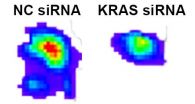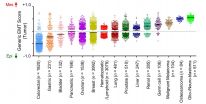(Press-News.org) CHAPEL HILL, NC - Researchers from the UNC School of Medicine and colleagues at The University of Texas MD Anderson Cancer Center have developed a new approach to block the KRAS oncogene, one of the most frequently mutated genes in human cancer. The approach, led by Chad Pecot, MD, an assistant professor of medicine at UNC, offers another route to attack KRAS, which has proven to be an elusive and frustrating target for drug developers.
The new method relies upon a specifically sequenced type of small interfering RNA - or siRNA. The findings, published in the journal Molecular Cancer Therapeutics, show that using a form of siRNA to halt KRAS not only dramatically stunted the growth of lung and colon cancers in cultured cells and mice but also stopped metastasis - the main cause of cancer deaths.
"KRAS has been widely regarded as an undruggable protein, but we show that that's simply not the case," said Pecot, the study lead author and member of the UNC Lineberger Comprehensive Cancer Center.
KRAS is a signaling molecule - a protein switch that triggers a cascade of molecular events that tell cells to grow and survive. Mutations in the KRAS gene create a switch that is perpetually "on," causing cells to divide uncontrollably. KRAS mutations are present in roughly 30 percent of human cancers, particularly lung, colon, pancreatic, and thyroid.
"It is the elephant in the room," Pecot said. "KRAS was one of the first cancer-causing genes ever discovered, and it was the obvious target to go after. People have been trying for decades to hit it, but they haven't had much luck."
Inhibiting KRAS signaling has been tricky because it lacks good pockets or crevices for small molecules and drugs to bind to. Some researchers have tried instead to target the proteins downstream in the KRAS signaling cascade, but those attempts have also had limited success.
Rather than try another conventional approach, Pecot decided to use a new genetic tool known as RNA interference - or RNAi - to destroy the KRAS protein before it fully forms. RNAi uses bits of synthetically engineered RNA - the single-stranded molecule transcribed from DNA - to silence specific genes. These bits of RNA bind to specific genetic messages called mRNA in the cell and direct enzymes to recognize the messages as enemies. In this context, the enzymes destroyed the genetic messages of KRAS mRNA so that KRAS can't be made. As a result, the cells don't grow, replicate, or move nearly as well.
RNAi has shown great promise in the treatment of liver diseases, viral infections, and cancers. To see if this approach could thwart the KRAS oncogene, Pecot and his colleagues first had to test different sequences of RNA to determine which one most effectively tagged KRAS for destruction. Of five RNA sequences, the researchers identified two candidates worthy to take into cancer models.
When they delivered these sequences into tissue culture cells, they found that the siRNAs destroyed more than 90 percent of the KRAS gene messages, significantly impairing the growth of cancer cell lines. The technique also led to marked reduction of two signaling molecules called pERK and pMEK, which lie downstream of KRAS and have been implicated in cancer cell proliferation and tumor growth.
Next, Pecot and his colleagues tested the siRNAs in mouse models of lung and colon cancer. They wrapped the sequences in protective lipid nanoparticles and delivered the siRNA solution into the mice. The researchers found that this treatment significantly slowed the growth of primary tumors. For example, tumors from colon cancer models that had been treated with the KRAS siRNAs were 69 percent smaller than tumors treated with control RNA sequences.
In addition, the researchers discovered that silencing KRAS stemmed the spread of cancer cells to other organs. The siRNA treatment reduced the number of these secondary malignant growths by about 80 percent in mice with lung cancer and to a similar degree in colon cancer models.
Pecot's findings come on the heels of two other papers using siRNAs to target KRAS, one from Frank McCormick's laboratory at the University of California at San Francisco and the other from Tyler Jacks' laboratory at the Massachusetts Institute of Technology. What sets the UNC study apart is that it demonstrates that this approach can be used to control the development of metastatic disease.
"Having all three papers come out at about the same time is encouraging because it means that KRAS is druggable if you use outside-the-box methods," Pecot said. "Now, we essentially have three platforms for targeting KRAS with siRNAs that may get to the clinic."
Pecot said the results, while promising, are just a first step in combating this cancer-causing gene. Ultimately, the siRNA sequences will have to be designed to specifically target the mutant form of KRAS without disrupting the normal form of the gene, which is necessary for maintaining normal growth in healthy cells.
INFORMATION:
Other UNC co-authors include UNC graduate student Salma Azam, and research specialist Trent A. Waugh. The senior author of this study was Anil Sood, MD, a professor of cancer biology at the University of Texas MD Anderson Cancer Center.
This research was funded through the National Institutes of Health, a Ben F. Love Fellowship in Innovative Cancer Therapies, and the Jeffrey Lee Cousins Fellowship in Lung Cancer Research.
Irvine, Calif., Nov. 13, 2014 -- A new bloodstream infection test created by UC Irvine researchers can speed up diagnosis times with unprecedented accuracy, allowing physicians to treat patients with potentially deadly ailments more promptly and effectively.
The UCI team, led by Weian Zhao, assistant professor of pharmaceutical sciences, developed a new technology called Integrated Comprehensive Droplet Digital Detection. In as little as 90 minutes, IC 3D can detect bacteria in milliliters of blood with single-cell sensitivity; no cell culture is needed.
The work appears ...
The Sudbury Basin located in Ontario, Canada is one of the largest known impact craters on Earth, as well as one of the oldest due to its formation more than 1.8 billion years ago. Researchers who took samples from the site and subjected them to a detailed geochemical analysis say that a comet may have hit the area to create the crater.
"Our analysis revealed a chondritic platinum group element signature within the crater's fallback deposits; however, the distribution of these elements within the impact structure and other constraints suggest that the impactor was a comet. ...
Among overweight and obese adults who had asthma and participated in weight loss programs, more severe asthma, male sex, and improvements in eating behaviors were all linked with better success at losing weight.
The finding that individuals with more severe asthma may have a greater motivation to lose weight suggests that these individuals should be targeted for intervention. Also, gender tailoring of weight loss programs may be useful to enhance weight loss success, said Lisa Wood, senior author of the Respirology study.
INFORMATION: ...
People can gauge the accuracy of their decisions, even if their decision making performance itself is no better than chance, according to a new study published in Psychological Science, a journal of the Association for Psychological Science.
In the study, people who showed chance-level decision making still reported greater confidence about decisions that turned out to be accurate and less confidence about decisions that turned out to be inaccurate. The findings suggest that the participants must have had some unconscious insight into their decision making, even though ...
Philadelphia, PA (November 13, 2014) -- Patients on dialysis are very vulnerable during emergencies or disasters, but many are unprepared for such situations, according to two studies that will be presented at ASN Kidney Week 2014 November 11¬-16 at the Pennsylvania Convention Center in Philadelphia, PA.
Dialysis patients are highly dependent on technologies to sustain their lives, with ongoing needs for transportation, electricity, and water for the dialysis apparatus. Interruption of these needs by a natural disaster can be devastating.
Naoka Murakami, MD, PhD ...
TORONTO, Nov. 13, 2014--Canadians with cystic fibrosis are living almost 20 years longer than they did two decades ago, according to a research paper published today.
The median survival age was 49.7 years in 2012, up from 31.9 years in 1990, Dr. Anne Stephenson, a respirologist and research at St. Michael's Hospital wrote in the European Respiratory Journal. Since the paper was written, Dr. Stephenson has updated the median survival age to include Cystic Fibrosis Canada data from 2013 and reported the median age of survival has in fact reached 50.9 years.
In addition, ...
Scientists from the Natural History Museum of Los Angeles describe a new distinctive fly species of the highly diverse genus Megaselia. The study published in the Biodiversity Data Journal proposes an innovative method for streamlining Megaselia species descriptions to save hours of literature reviews and comparisons.
The new species, M. shadeae, is easily distinguished by a large, central, pigmented and bubble-like wing spot. The description is part of the the Zurquí All Diptera Biodiversity Inventory (ZADBI) project, and represents the first of an incredible ...
Mice bred to carry a gene variant found in a third of ALS patients have a faster disease progression and die sooner than mice with the standard genetic model of the disease, according to Penn State College of Medicine researchers. Understanding the molecular pathway of this accelerated model could lead to more successful drug trials for all ALS patients.
Amyotrophic lateral sclerosis, commonly known as Lou Gehrig's disease, is a degeneration of lower and upper motor neurons in the brainstem, spinal cord and the motor cortex. The disease, which affects 12,000 Americans, ...
Philadelphia, November 13, 2014 - Associations between opioid-related overdoses and increased prescription of opioids for chronic noncancer pain are well known. But some suggest that overdose occurs predominately in individuals who obtain opioids from nonmedical sources. In a new study published in the November issue of the journal PAIN®, researchers in Denmark found an increased risk of death associated with chronic pain without opioid treatment, as well as an even higher risk among those prescribed opioids for long-term use and a somewhat lower risk associated with ...
Scientists at the Cancer Science Institute of Singapore (CSI Singapore) at the National University of Singapore (NUS) and their collaborators have developed a scoring scheme that predicts the ability of cancer cells to spread to other parts of the body, a process known as metastasis. This system, which is the first of its kind, opens up the possibility to explore new treatments that suppress metastasis in cancer patients. The findings were published in EMBO Molecular Medicine in September.
Led by Professor Jean Paul Thiery, Senior Principal Investigator, and Dr Ruby Huang, ...



